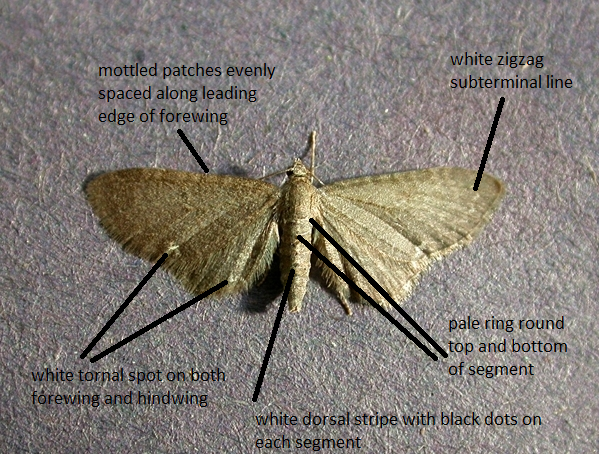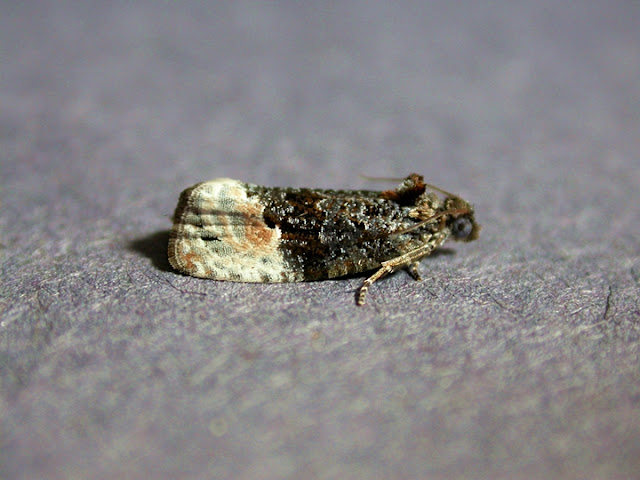Although supposedly on leave this week the prospect of a meeting on the future of moth recording at DERC Dorchester scheduled for Tuesday afternoon and an opportunity to deliver a Range Rover just 25 miles away on a two day trip I jumped at the chance. With the car delivered and actually finding a parking space for the Ranger and trailer fairly close to the venue in Dorchester it all started well. A productive meeting ensued, an evening meal at a local hostelry with 'lashings of ginger beer' and then up to one of my favourite trapping sites of old, near Hardy's Monument, Blackdown. The nod to the Comic Strip production of Five Go Mad in Dorset refers to me questioning what on earth was I doing exposing myself to the inclement weather forecast, humid, very breezy and with heavy thundery showers and dozing in the Ranger when I could have been tucked up in the dry in a proper bed.
 |
| Hardy's Monument, Blackdown |
What a fantastic night! Despite the heavy rain showers and spectacular light show from the thunder clouds, by using a strategically placed umbrella it offered at least some protection. I did get wet several times rescuing the brolly which was whisked away by squally winds but luckily the bulb did not get damaged by the rain. The monument can just be seen on the horizon in the photo above. The highlight for me was fantastic views of singing, calling and wing-slapping Nightjars so close I could see the orange reflection of their eyes; they may well of course have been attracted to the moths above the trap! I was able to attract over 300 moths to the trap and it was great to reacquaint myself with some southern species again such as Four-spotted Footman, Black Arches and White-point. Due to limited time in the morning and not many pots I was unable to take any photos, but did hang on to this tiny 5-6mm micro for identification.
 |
| Elachista atricomella |
The full list for the night is as follows:
Dark Dagger / Grey Dagger (Acronicta tridens/psi) 3
Uncertain/Rustic agg. (Hoplodrina alsines/blanda) 8
Common Rustic agg. (Mesapamea secalis agg.) 12
Marbled Minor agg. (Oligia strigilis agg.) 14
17.003 Honeysuckle Moth (Ypsolopha dentella) 1
28.009 White-shouldered House-moth (Endrosis sarcitrella) 1
32.018 a moth (Agonopterix heracliana) 1
35.031 a moth (Helcystogramma rufescens) 1
35.056 a moth (Metzneria lappella) 1
38.025 a moth (Elachista atricomella) 1
41.002 a moth (Blastobasis adustella) 1
49.092 a moth (Phtheochroa inopiana) 1
49.109 a moth (Agapeta hamana) 1
49.341 a moth (Cydia splendana) 2
63.037 a moth (Udea olivalis) 2
63.038 Mother of Pearl (Pleuroptya ruralis) 2
63.093 a moth (Agriphila straminella) 4
65.009 Buff Arches (Habrosyne pyritoides) 3
66.003 Lackey (Malacosoma neustria) 7
66.010 Drinker (Euthrix potatoria) 1
69.006 Privet Hawk-moth (Sphinx ligustri) 1
69.016 Elephant Hawk-moth (Deilephila elpenor) 6
70.013 Small Fan-footed Wave (Idaea biselata) 2
70.016 Riband Wave (Idaea aversata) 1
70.016 Riband Wave [non-banded form] (Idaea aversata ab. remutata) 1
70.037 Clay Triple-lines (Cyclophora linearia) 4
70.087 Purple Bar (Cosmorhoe ocellata) 1
70.093 Barred Straw (Gandaritis pyraliata) 1
70.094 Small Phoenix (Ecliptopera silaceata) 2
70.207 Clouded Border (Lomaspilis marginata) 3
70.214 Tawny-barred Angle (Macaria liturata) 1
70.226 Brimstone Moth (Opisthograptis luteolata) 3
70.237 Early Thorn (Selenia dentaria) 1
70.241 Scalloped Oak (Crocallis elinguaria) 11
70.252 Peppered Moth (Biston betularia) 5
70.258 Willow Beauty (Peribatodes rhomboidaria) 3
70.284 Barred Red (Hylaea fasciaria) 2
70.297 Grass Emerald (Pseudoterpna pruinata) 2
70.305 Common Emerald (Hemithea aestivaria) 2
71.021 Coxcomb Prominent (Ptilodon capucina) 2
71.025 Buff-tip (Phalera bucephala) 8
72.002 Straw Dot (Rivula sericealis) 1
72.003 Snout (Hypena proboscidalis) 5
72.010 Black Arches (Lymantria monacha) 7
72.013 Yellow-tail (Euproctis similis) 1
72.019 Buff Ermine (Spilosoma lutea) 2
72.024 Ruby Tiger (Phragmatobia fuliginosa) 1
72.026 Garden Tiger (Arctia caja) 2
72.035 Rosy Footman (Miltochrista miniata) 6
72.041 Four-spotted Footman (Lithosia quadra) 9
72.042 Red-necked Footman (Atolmis rubricollis) 2
72.043 Buff Footman (Eilema depressa) 48
72.044 Dingy Footman (Eilema griseola) 5
72.045 Common Footman (Eilema lurideola) 3
72.053 Fan-foot (Herminia tarsipennalis) 1
73.001 Spectacle (Abrostola tripartita) 3
73.032 Nut-tree Tussock (Colocasia coryli) 37
73.162 Dark Arches (Apamea monoglypha) 12
73.216 Dun-bar (Cosmia trapezina) 5
73.293 Smoky Wainscot (Mythimna impura) 2
73.297 White-point (Mythimna albipuncta) 1
73.317 Heart and Dart (Agrotis exclamationis) 2
73.325 Shuttle-shaped Dart (Agrotis puta) 1
73.338 True Lover's Knot (Lycophotia porphyrea) 2
73.343 Broad-bordered Yellow Underwing (Noctua fimbriata) 2
73.345 Lesser Yellow Underwing (Noctua comes) 2
73.346 Least Yellow Underwing (Noctua interjecta caliginosa) 2




























